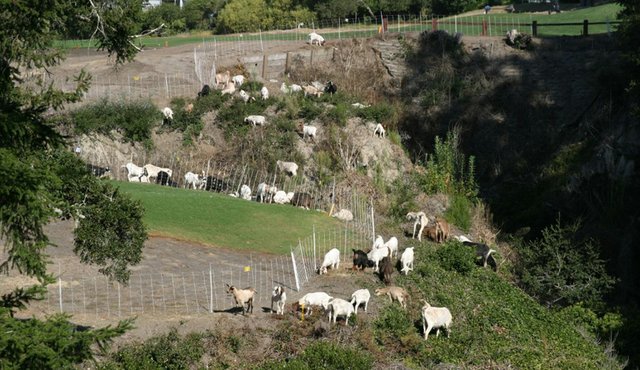When you come to think of it that is the secret of most of the great holes all over the world. They all have some kind of a twist. C.B. MACDONALD
Tiger, Elin And Halloween
/Sent in by a reader...uh, I see Tiger, I see Elin, but what's the guy in the middle supposed to be?

Love the homemade Nike swoosh hats!

“Alo, Presidente.”
/Lee Westwood To OWGR Algorithms: You Like Me, You Really, Really Like Me!
/"The IGF could’ve instituted a 36-hole cut instead of shortening the tournament."
/ Sean Martin takes issue with the lack of an on-the-spot call by the International Golf Federation to prevent a virtual washout day of weekend World Amateur Team Championship golf, but what really scares me about this episode is that it's precisely the kind of thing that they use to justify the dead-on-arrival 72- hole individual stroke play format for the Olympics.
Sean Martin takes issue with the lack of an on-the-spot call by the International Golf Federation to prevent a virtual washout day of weekend World Amateur Team Championship golf, but what really scares me about this episode is that it's precisely the kind of thing that they use to justify the dead-on-arrival 72- hole individual stroke play format for the Olympics.
There’s nothing the IGF can do about the weather. But its insistence on emphasizing participation over competition in a tournament billed as a “world championship” has frustrated many players and coaches.
“I’m an idiot."
/At least Ryuji Imada was honest about his inability to read the local rule sheet at the Mission Hills Star Trophy, costing him 26 penalty strokes and a chance at the lead. Andrew Both reports:
Due to the soft state of the Blackstone course, players were allowed to lift, clean and place their balls. Imada assumed this meant within one club length of the original position, as is standard procedure on the PGA Tour.
However, the European and Asian Tours use the length of one scorecard as a measurement. It wasn’t until the 12th hole that fellow competitor Danny Lee noticed Imada was breaking the rule and informed him.
Better late than never!
This is fun too:
Imada wasn’t the only player to screw up. Nick Faldo was disqualified for picking up his ball after missing a putt at the eighth hole.
Evidently, he forgot that the pro-celebrity format includes a professional only competition. He didn’t realize the mistake until after teeing off at the next hole by which time it was too late to rectify.
Turning Stone Championship, RIP
/Flashback: "For six years they will influence the selection of those offered positions as USGA officers, Executive Committee members and Nominating Committee members."
/Q&A With George Peper
/ George Peper and Malcolm Campbell have teamed with principal photographer Iain Lowe to produce True Links, a glorious take on links golf and the 200 or so truly authentic links. Instead of pandering to readers as most coffee table books tend to do, Peper and Campbell treat the reader intelligently by presenting a demanding list of requirements for a course to be considered an authentic links. In between Lowe's architecturally-informative images are wise words and a true education in links golf characteristics.
George Peper and Malcolm Campbell have teamed with principal photographer Iain Lowe to produce True Links, a glorious take on links golf and the 200 or so truly authentic links. Instead of pandering to readers as most coffee table books tend to do, Peper and Campbell treat the reader intelligently by presenting a demanding list of requirements for a course to be considered an authentic links. In between Lowe's architecturally-informative images are wise words and a true education in links golf characteristics.
Peper was kind enough to answer a few questions about the book and life in St. Andrews, where the former Golf Magazine editor now resides.
Q: The title True Links suggests you are weeding out the faux links from the authentic links and you end the book with 246 courses you list as "authentic links." What inspired the idea and how did you go about doing this?
GP: About three years ago my co-author Malcolm Campbell, along with Brian Keating, the developer of Machrihanish Dunes, started something called The Links Association, whose mission is to promote, protect, and preserve links courses worldwide. At that time, they began to compile a list of genuine links. When I got wind of their project I suggested a book. Artisan liked the idea, and we were off.
Our first step was to agree on a definition—not of links per se but of linksland. As our basis we used the British Golf Museum’s definition which describes linksland as "a stretch of land near the coast on which the game is played, characterized by undulating terrain, often associated with dunes, infertile sandy soil, and indigenous grasses such as marram, sea lyme, and the fescues and bents which, when properly managed, produce the fine, textured, tight turf for which links are famed."
The maritime environment was important to us. Surely, there are many fine courses around the world that look and play like links, including some recent additions such as Sand Hills, Chambers Bay, and your own course at Rustic Canyon, but without the sea aspect you just can’t have the authentic experience of links golf.
That narrowed the field of candidates to about 500 courses, many of which were eliminated because of their playing conditions. Courses such as Pebble Beach, Old Head in Ireland, and Nefyn & District in Wales are not links, they’re clifftop courses, without the firm sand base a links course requires. Others were in tropical climates that couldn’t sustain the grasses necessary for fast-running conditions, at least not year round. Some, like Maidstone, had a few authentic links holes but not enough to characterize the course as a links. Others, like Scotscraig near St Andrews, had too many trees lining the fairways. Finally, there were a few courses, such as Le Touquet in France and Le Zoute in Belgium that had strayed from their original design and agronomy to the point that they could not longer be called links.
Working over the course of a year and with the help of a kitchen cabinet--about a dozen golf course architecture mavens around the world--Malcolm and I pared our list to a final count of 246, and with relatively little disagreement.
Q: You've been living in St. Andrews for some time now and based on the book, it appears you've fallen for several lesser known links. If you were an American planning a trip to the St. Andrews area, tell us what lesser-known links you'd suggest are essential stops.
GP: Actually, the only links I’ve truly fallen for is the new Castle Stuart course by Mark Parsinen and Gil Hanse. That is a must play, worth every minute of the three-hour drive from St Andrews to Inverness.
For the most part, however, the well-known links are well known for a reason—they’re the best courses. There aren’t too many hidden gems. One exception in the St Andrews area would be Lundin Links, Malcolm’s home course, where an insidious little burn adds to the fun. Another is Elie, a “gentleman’s course” that’s almost always in great condition and has a couple of spectacular holes along the water.
Between Malcolm and me, we’ve played just about all of the 84 links in Scotland, and if you want the truth, about 50 of them aren’t worth the trouble—they’re either very short or relatively undistinguished. But that doesn’t make them any less true links.
Q: Iain Lowe is the principal photographer for True Links and you two collaborated on his new book, Golf Links of Scotland. You've worked with a lot of photographers over the years, what is it that you like about his work?
GP: Iain is a St Andrean. He appreciates that links courses have many moods, and he knows how to capture them. His aerial photography is the best in the business (he began his career shooting from the skies with the RAF). And he really cares. He will go back to a site two or three times and wait several days to get the right shot. During the final production of Golf Links of Scotland he spent two weeks at a printing press in China, ensuring that the color reproduction was spot on.
Q: A lot of modern tour professionals don't like the idea of playing links golf for more than a week at a time for fear of messing up their swings. Now that you mostly only play links golf, what do you say to that mentality?
GP: The rank and file U.S. pros complain too much. If, at their level, they can’t adjust to links conditions for a week without losing their swings, let them take that week off. The great players have no problem. Look at Bernhard Langer this year—he won the British and US Senior Opens on back to back weeks at Carnoustie and Sahalee. Can you think of two more dissimilar courses—not to mention 6000 miles apart!
That said, I’ll admit that my own game has undergone some major changes since I moved to St Andrews— especially because I play most of my golf on the Old Course. Where once I had a high fade, I now have a low draw. Where once I had a great short game, I now have the yips on chip and pitch shots. In fact, the only part of my game that has improved in the last few years is the ability to two-putt from 90 feet, an absolutely useless skill anywhere else in the world.
Q: You end the book with a chapter about the future of links and golf courses and some of your hope hinges on Donald Trump proving you can build a sustainable links. That doesn't sound good for the game, no?
GP: I’m not sure what you mean there. I do think Trump’s course is going to be spectacular. I’ve walked the land a couple of times, and there’s no question the dunes he has are the largest on any links in the world—by far. I also think he made the right choice of architect in Martin Hawtree, a low-key guy who will counterbalance The Donald’s glitz to produce a course that plays dramatically through those dunes without being overpowered by them. And in contrast to Trump’s other courses around the world, this one will be relatively low maintenance and sustainable. Whether or not he succeeds with his ambitious real estate plans, the course will live happily ever after. It may not turn out to be “the best course in the world” as Trump predicts, but I’m confident it will be an important addition to the Scottish golf landscape—and the world’s 247th true links.
Q: At this year's Open Championship you gave a wonderful speech at the Association of Golf Writers dinner in which you pretty much let the golf establishment know they wouldn't be missed if they disappeared from the scene. Have any sheep heads turned up in your bed? What kind of reaction did you get?
GP: Thanks. I guess you’re referring to my closing rant that, if professional golf were to vanish from the earth tomorrow, golfers around the world would observe a moment of silence and then go right on play--the pros are nice but not necessary.
The reaction that night and the rest of the week was terrific and all positive. Someone sitting at Graeme McDowell’s table told me he was smiling and nodding in agreement as I spoke, and when I sat down even Monty gave me a thumbs up. I’ve since learned that the one guy who wasn’t pleased was—no surprise—Tim Finchem. I guess if I were he I’d have had the same reaction. That said, I don’t anything from my mouth or pen will ever have much effect on the PGA Tour!
Ridley And Driver: Theeeeyyyyy'rrrrreeee Back!
/Only last night did I try to dig up the USGA nominating committee folks who chipped away even more of the USGA's credibility by nominating a trophy wife while ejecting a quality committee member. Finding no names online, I emailed USGA communications and they kindly supplied the info.
Now that I've cleaned up the ejected beverage from my keyboard and screen, I give you those names from the past that many hoped they'd never see again in a USGA-related item.
Fred Ridley
Walter Driver
Youngsuk Chi
Sarah LeBrun Ingram
M.J. Mastalir, Jr.
Okay, we know how these boys work. You might as well not even bother with the last three names. The chairs in the room had more influence. Those three poor souls voted how Chairman Ridley and Father Driver wanted or faced possible jail time or whatever misery Goldman Sachs' security team cooks up.
For those of you new readers to the blog, these two are the most reviled least appreciated USGA presidents of all time who jump-started several destructive internal policies that have corporatized the organization and expedited the departure of quality individuals. They also used golf course setups to mask regulatory buffoonery to disastrous effect, making Shinnecock a verb and helping the world understand just how far some will go to protect imaginary margins over the best interests of the game. And as first revealed here, Ridley and Driver parlayed the job of president into a perksfest highlighted by private jet travel. (The rest of the jet saga was detailed here, here, here and here.)
Driver, of course, is the mastermind of so many of these dreadful policies. A Goldman man who hilariously used his Blackberry at USGA events and majors even when they were banned, he was so lovingly profiled by Furman Bisher, who swooned over the man's "awesome name" and handsomeness "in a rustic sort of way." (And you thought the Tiger email chain saga was embarrassing!)
That's about where the compliments ended.
Driver now apparently continues to be behind the overall shift in USGA culture that places power and money as priority one, no matter the human costs or impact on the game. And that's ultimately what's so sad about this latest hiccup. They've placed another member on the executive committee who is married to one of the driving forces behind disastrous USGA policies. (Reg Murphy was a big fan of shuttering Golf Journal, which ushered in the decline of the once powerful membership program.)
I'll never understand the dynamics of that whole Sea Island-Atlanta cabal, nor do I care. I just wonder what they get out of it? Because so few people respect what they do and how they do it. And the results speak for themselves. It still goes back to how the USGA governs the game and the more you take bright people out of the room and replace them with undeserving types, the more the game suffers.
Hall Thompson, RIP
/One of the stranger and sadder chapters in the game's history ends with the passing of Hall Thompson.
Goats Are The Future!
/ Julie Williams follows up with a story on the goats thinning native grass areas at Pasatiempo and shares this from Terry Hutchens.
Julie Williams follows up with a story on the goats thinning native grass areas at Pasatiempo and shares this from Terry Hutchens.
Terry Hutchens, extension goat specialist at the University of Kentucky, notes that employing goats for brush clearing is a West Coast idea making its way east. But then, so are goats.
“It’s been used in the West for years, but east of the Mississippi River, it’s a phenomenon,” said Hutchens, who predicts that using goats for brush management (on golf courses or otherwise) will be common practice in 10 years.
For the past two years, Hutchens has been involved in a student research project that introduced goats to three landfills located on Bluegrass Station, a former Army base in Fayette County, Ky., now operated by the state. Groups of four goats first were released in quadrants slightly smaller than a half-acre to assess their land-clearing capabilities. The project was taken one step further when goats ended up at Avon Golf Course, a public nine-hole facility on Bluegrass Station, on a two-month trial basis.











